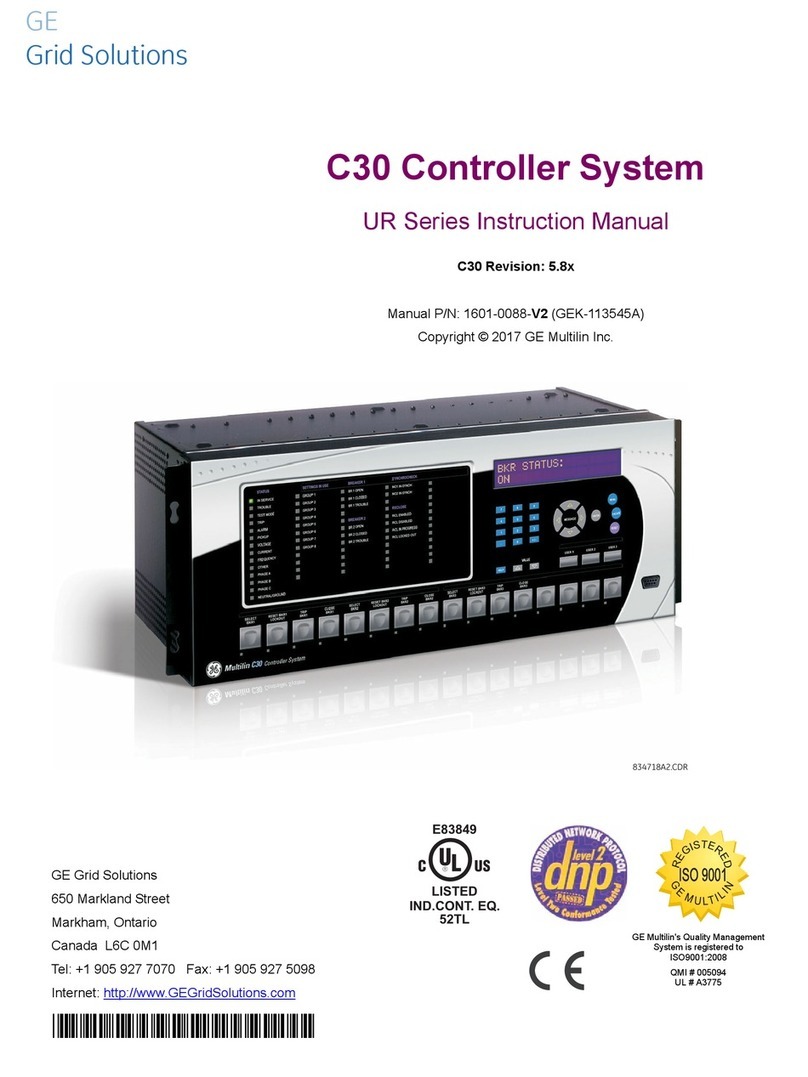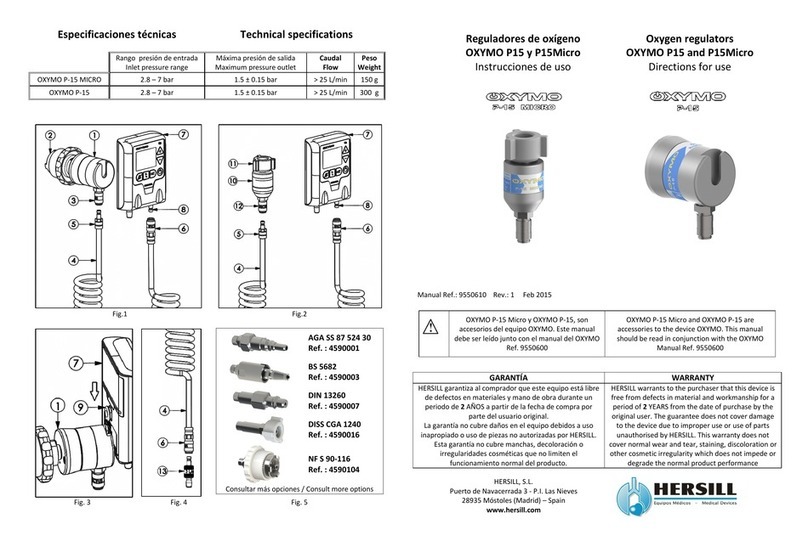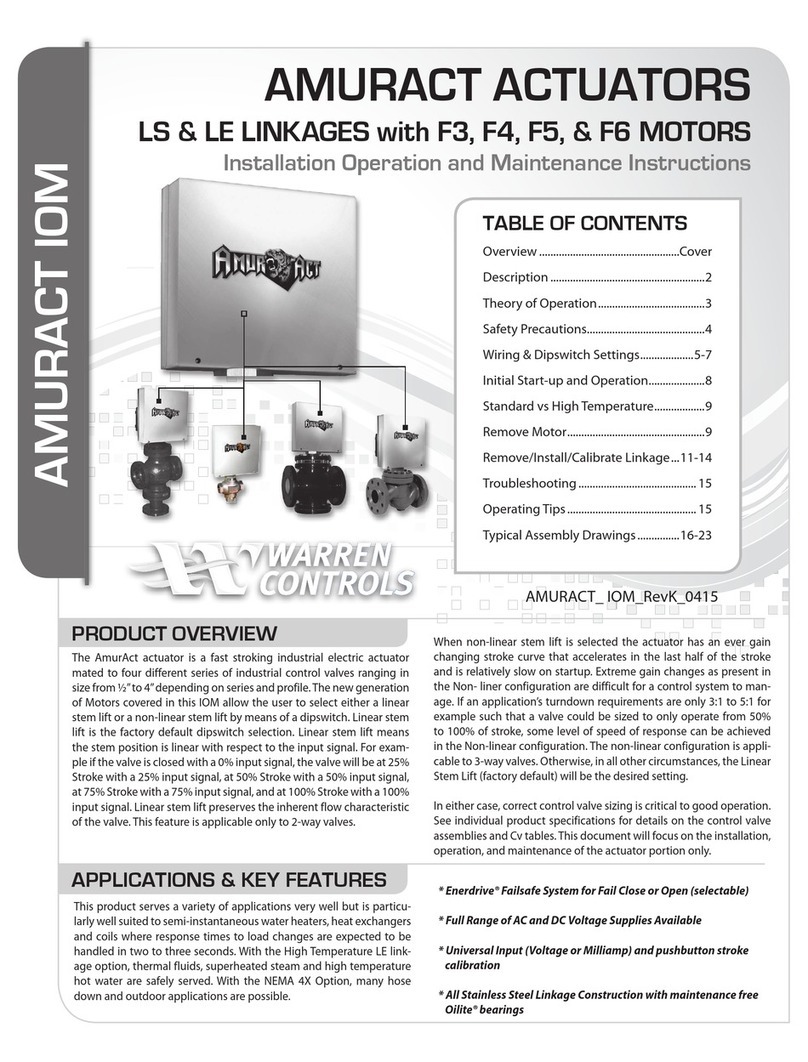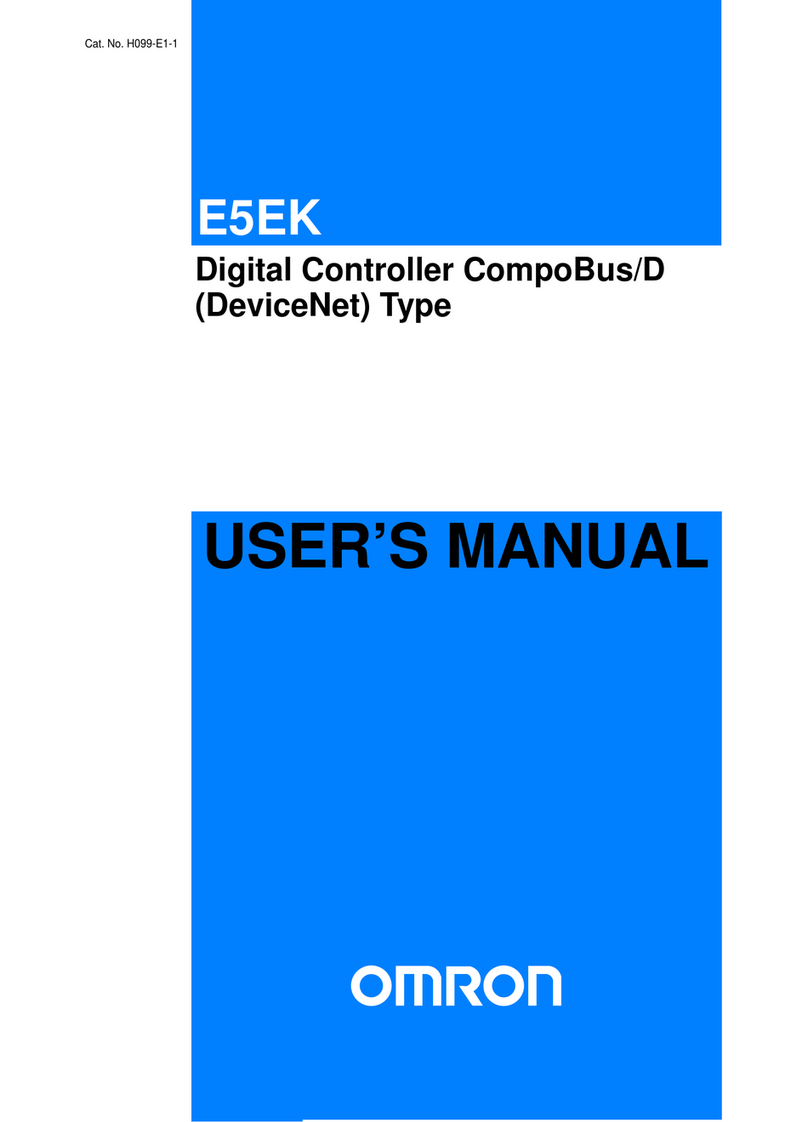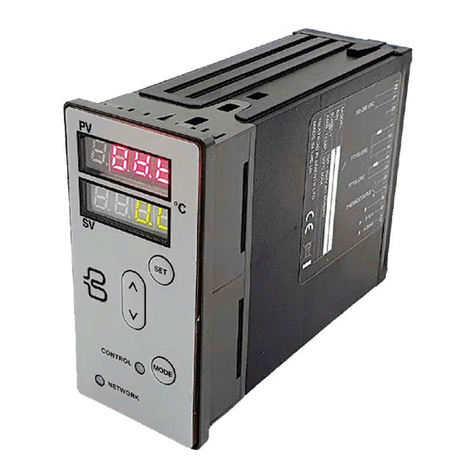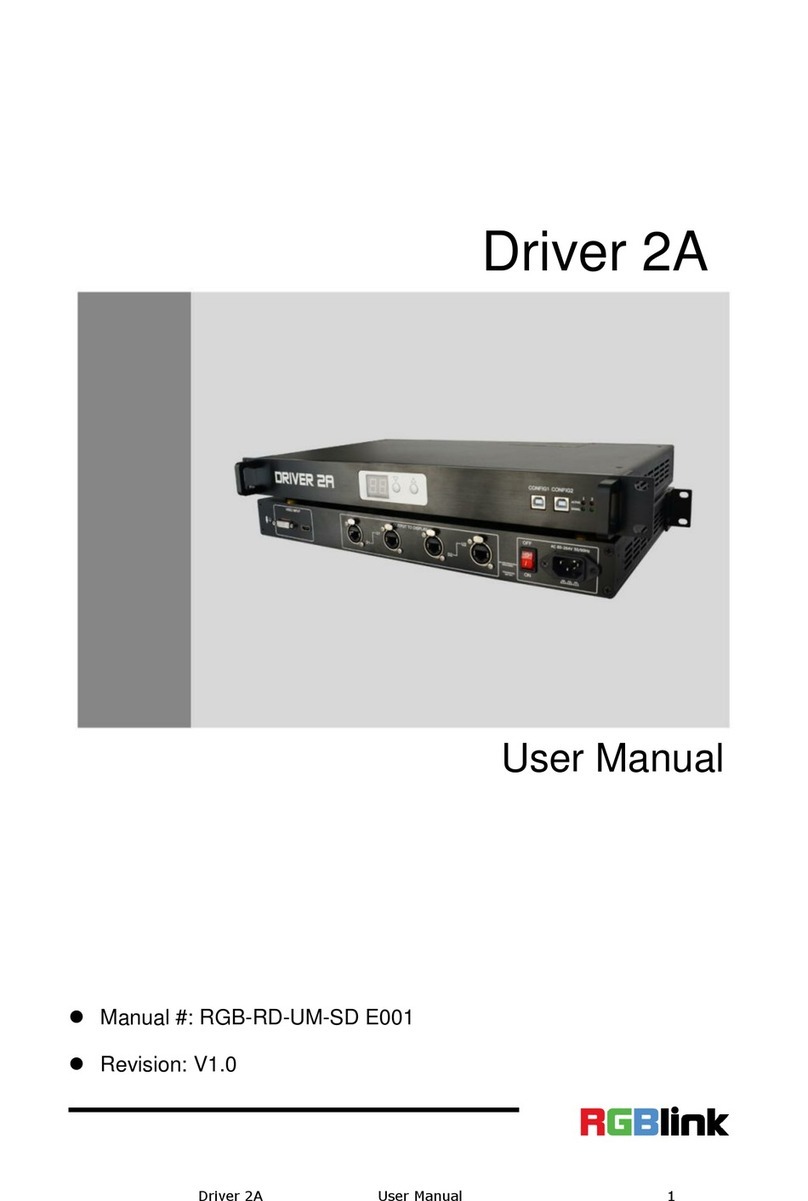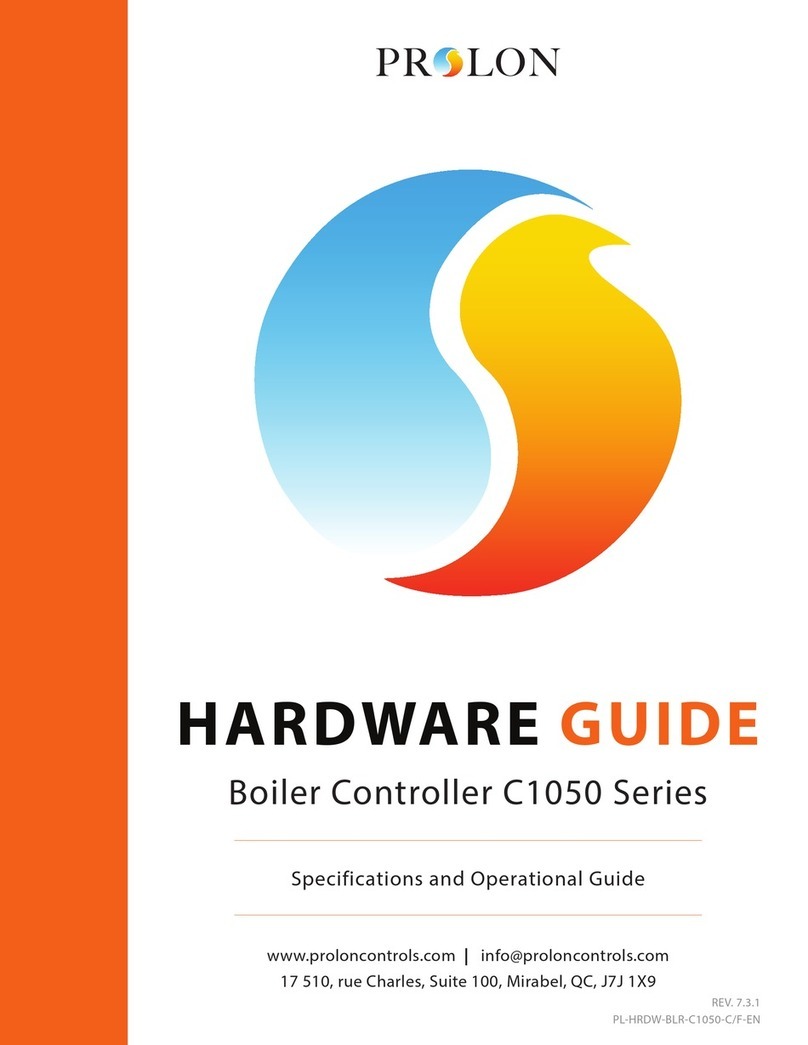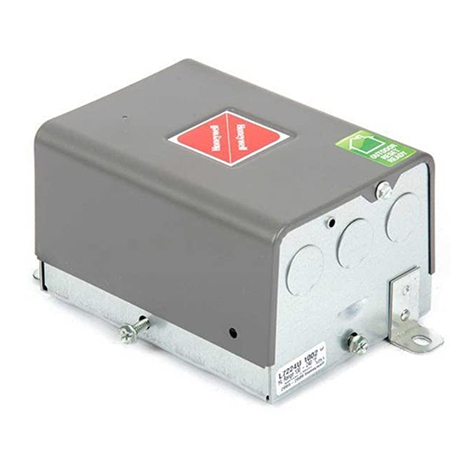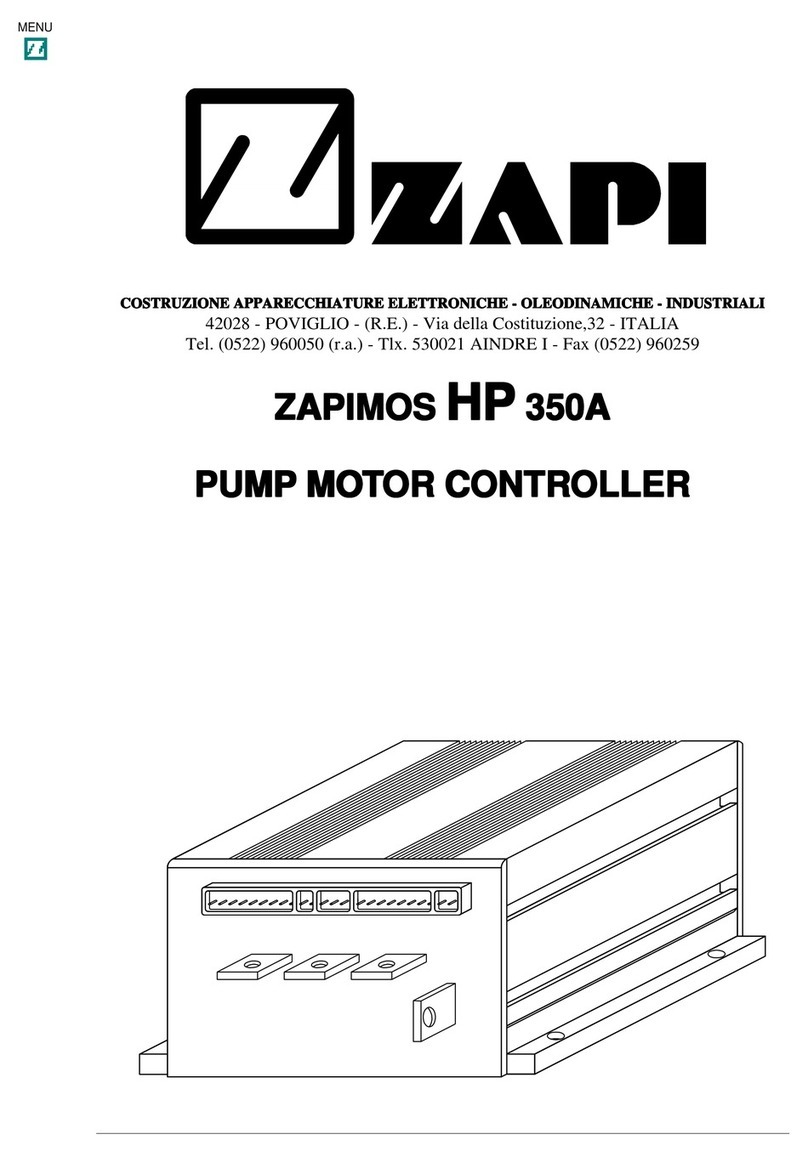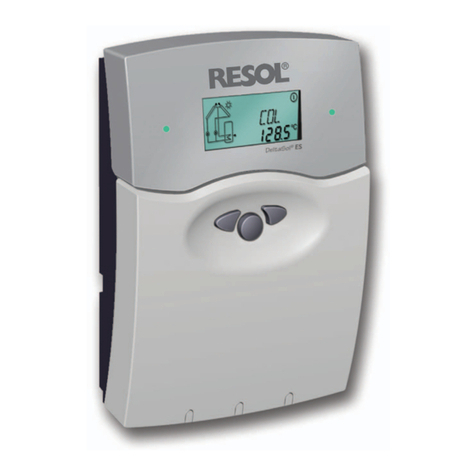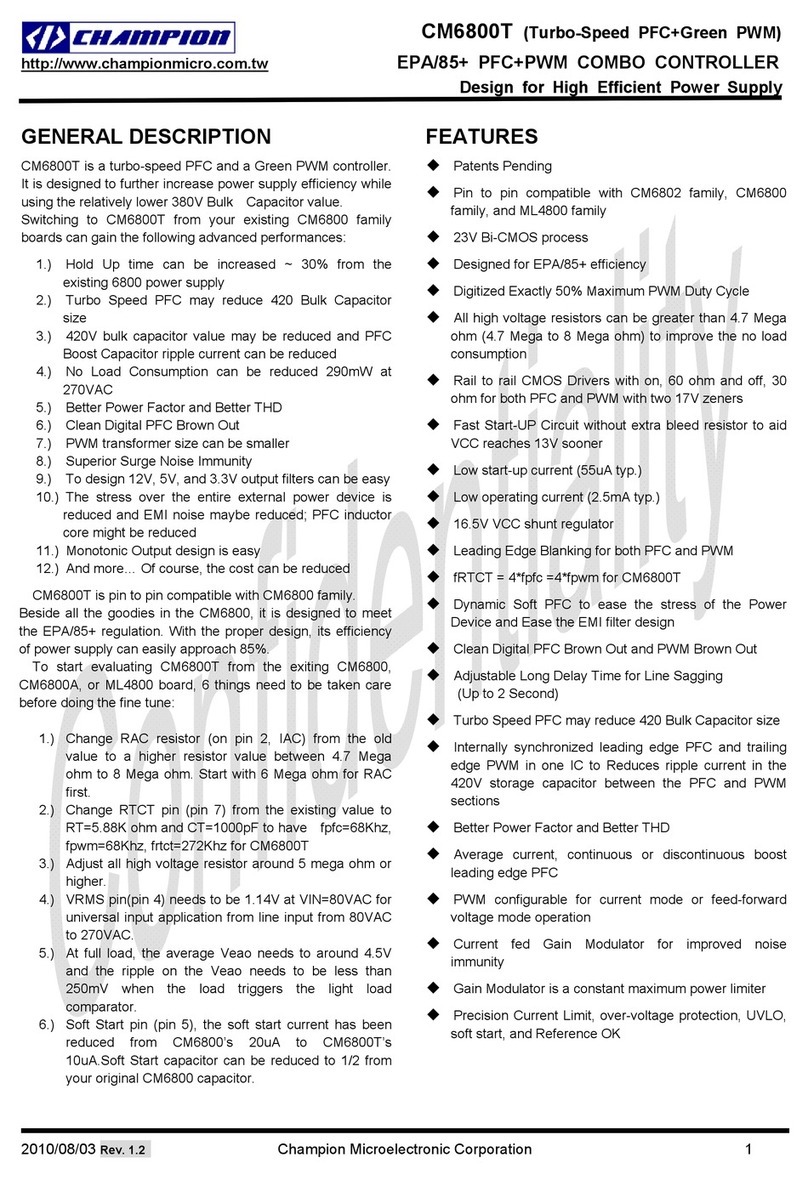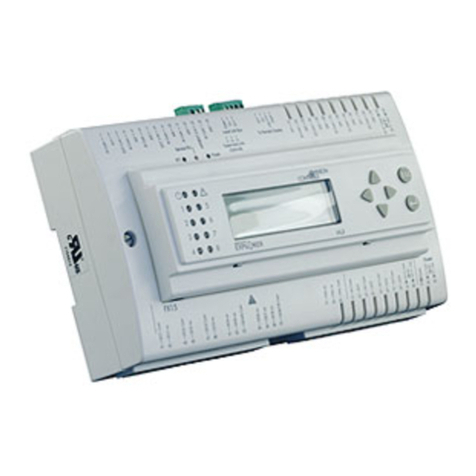BEIER-Electronic SFR-1 User manual

GB Sound speed controller SFR-1
06.02.2019 BEIER-Electronic 1
Operating manual
Sound Speed
Controller
SFR-1
V1.10
BEIER-Electronic
Winterbacher Str. 52/4, 73614 Schorndorf - Weiler
Telefon 07181/46232, Telefax 07181/45732
eMail: modellbau@beier-electronic.de
Internet: http://www.beier-electronic.de/modellbau

GB Sound speed controller SFR-1
2 BEIER-Electronic 06.02.2019
Table of Contents
Table of Contents....................................................................................................... 2
Introduction................................................................................................................. 4
Safety notes ............................................................................................................... 5
Additional information and help.................................................................................. 5
Technische Daten ...................................................................................................... 6
Pin assignment........................................................................................................... 8
Wiring diagram........................................................................................................... 9
Installation................................................................................................................ 10
Connection............................................................................................................... 10
Setup (teaching function).......................................................................................... 16
Loudspeaker............................................................................................................. 17
Volume control ......................................................................................................... 18
Sounds..................................................................................................................... 19
Engine sound ........................................................................................................... 20
Turning on/off engine sound..................................................................................... 22
Engine sound 2 ........................................................................................................ 23
Functions of SFR-1................................................................................................... 24
Additional sounds 1 - 30........................................................................................... 26
Random sounds....................................................................................................... 28
WAV-Player.............................................................................................................. 28
Functional assignment at proportional channels #1 - #6.......................................... 30
Stick simulation via keys or switches........................................................................ 32
Nautic mode / multiswitch mode............................................................................... 33
One-channel multi-function selection (EKMFA)........................................................ 34
Sum signals S-BUS and SUMD ............................................................................... 34
Digital switches at sum signal SUMD3 ..................................................................... 35
Switching outputs ..................................................................................................... 35
Output sequences .................................................................................................... 42
Servo outputs ........................................................................................................... 43
Function sequences ................................................................................................. 44
Voltage monitoring.................................................................................................... 44
Current monitoring.................................................................................................... 45
LEDs on SFR-1 ........................................................................................................ 46
Kraftwerk EasyBus lighting boards........................................................................... 47

GB Sound speed controller SFR-1
06.02.2019 BEIER-Electronic 3
PC software „SFR-1 Sound-Teacher“ ...................................................................... 48
Using software „SFR-1 Sound-Teacher“ .................................................................. 50
Saving sounds and configurations on SD card......................................................... 85
Transferring configurations with data cable K-USB-2............................................... 86
Adjustments of driving sound with the driving sound diagram.................................. 87
Sound simulation...................................................................................................... 89
Testing functions with help of data cable K-USB-2 .................................................. 89
Diagnosis.................................................................................................................. 90
Firmware update....................................................................................................... 93
Neue Sounds am PC aufnehmen............................................................................. 94
Sounddateien konvertieren....................................................................................... 97
Sounds am PC bearbeiten ....................................................................................... 98

GB Sound speed controller SFR-1
4 BEIER-Electronic 06.02.2019
Introduction
The SFR-1 is a multifunctional module and combines the functions of the sound
module USM-RC-2 and the speed controller UFR-1230. It comes with a large light
control unit, three servo outputs and an infrared port for the light module SM-IR-16-2,
to forward light signals to a trailer.
The SFR-1 is suitable for all types of RC standard transmitter. With the various
setting options the SFR-1 can be easily adjusted to nearly all model requirements
and driving behaviours. For an easy start we have more than 170 ready to use sound
projects and 700 sound files for various types of models. Of course, own recordings
can be used, as well.
Sound functions:
For an authentic sound of the model, sounds can be selected for following areas:
•Driving and engine sounds (speed-dependent)
•Additional sounds (e.g. horns, hydraulic and compressed air noises)
•Random sounds (e.g. squeaking, animal and ambient sounds)
Driving functions:
Brushed and bell-armature motors (DC) can be controlled smooth and realistic with
the SFR-1. An ideal driving behavior can be achieved through a variety of settings.
The speed controller on the SFR-1 has following characteristics:
•Cruise control functions
•Different brake functions (with hand- and emergency brake)
•Adjustable load regulation
•Adjustable mass inertia
•Steering inertia (with adjustable steering ankle limits)
•Adjustment of throttle curve for different driving behaviours
Light functions:
To realize different light effects, the SFR-1 has 16 switching outputs to connect
LEDs, lamps and other consumers. Light functions, such as low beam, rear light,
brake light, indicator lights, warning lights, flickering lights, etc. can be easily
implemented and controlled.
All light functions can be activated or deactivated automatically with sounds and
movements.
Servo movements:
With two additional servo outputs, movements can be synchronised to the played
sound.

GB Sound speed controller SFR-1
06.02.2019 BEIER-Electronic 5
Safety notes
•Please read this operating manual carefully and keep it for future use!
•The integrated circuits on the sound module are sensitive to electrostatic
charge. Therefore it is important that you don’t touch these components,
before discharging yourself (e.g. through a grip onto a grounded device).
•Under certain circumstances unfavourable placement and wiring of the sound
module in the model may lead to restriction of transmitter range (mainly with
35/40 MHz transmitter).
•The sound module should only be used with supply voltages that are given in
the technical data.
•Always switch off power first before connecting the module!
•The sound module is not suitable for children under 14 years.
Additional information and help
You have problems with your sound module and need additional information?
No worries, we are here to help you!
BEIER-Electronic forum
Check out our BEIER-Electronic forum on our website.This is the most appropriate
place to get quick and competent assistance. In our forum you can ask questions
and receive practically proven answers from us and from other forum user. Through
an intensive exchange of expertise and experience, all forum users can benefit from
the information, presented solutions and ideas. Maybe your question / problem has
already been described and you can find immediately the solution (e.g. in the FAQ).
BEIER-Electronic on facebook
Also visit us on facebook. You can find news and additional information about our
products there. Customers of us also founded a facebook group, where you can
present your project and get help, just like in our forum.
YouTube tutorials
If you have questions about basic functions of the sound module SFR-1, please
watch our YouTube video tutorials with English subtitles. In these videos we explain
for example how to connect the sound module and how to program and control
different functions.

GB Sound speed controller SFR-1
6 BEIER-Electronic 06.02.2019
Technische Daten
Supply Voltage (Ub):
6 – 18 V DC
Power consumption:
Bias current: approx. 1 mA
Standby current (sound, motor and outputs off):
approx. 80 mA
Motor current:
Max. 30 A continuous current,
60 A short-term current (1 minute)
BEC voltage:
approx. 5,6 V
BEC current:
max. 3 A continuous current, 5 A short term (10
seconds)
Proportional inputs:
6 inputs
Supported protocols:
•PPM / PCM (1,000 - 2,000 ms)
•Sum signal S-Bus (max. 16 channels)
•Sum signal SUMD/SUMD3 (max. 16
channels)
•Nautic / Multiswitch / Multikanal / EMS
Servo outputs:
3 outputs (1,000 - 2,000 ms)
Switching outputs:
16 outputs (npn – open collector),
max. 1,5 A each output, the total current of all
outputs is not allowed to exceed 3,0A
Audio amplifier:
20 W (mono)
Recommended loudspeaker:
4 – 8 Ω
Volume setting:
With extra poti (100 kΩ) and/or by the radio
Memory for sound files:
Micro SD card (1 to 32 GB)
May. length of sound:
approx. 180 minutes per 1 GB
Supported file format:
WAV-Format, 8/16 Bit, Mono/Stereo, 22/44 kHz
Sound output:
16 Bit, Mono, 44 kHz
Number of possible sounds:
•5 running steps/gears (internally in up to 255
steps accelerated)
•8 change sounds between the running
steps/gears
•Turn on noise, turn off noise, starting noise,
stopping noise, idling noise, brake noise,
reverse engine noise, curve squeal, flashing
lights sound
•30 additional sounds (for example via prop.-
channels)
•8 random sounds (random generator)
•30 tracks for WAV-Player
Random sound generator:
Times between 1 to 999s adjustable
Additional ports:
•Programming interface for data cable
•Port for infrared diode of light module
SM-IR-16-2

GB Sound speed controller SFR-1
06.02.2019 BEIER-Electronic 7
Protection features:
•Short circuit protection at motor output stage
•Short circuit protection at switching outputs
•Short circuit protection at BEC
•Temperature monitoring
•Battery voltage monitoring
•Protection while switching on power supply
•Failsafe for proportional inputs
Cables for connection:
•For battery: 2 x 1,5 mm², length approx. 15
cm (with Deans T female connector)
•For Motor: 2 x 1,5 mm², length approx. 15
cm
•For receiver: servo patch 3 x 0,14 mm²,
length approx. 30 cm
Permissible ambient
temperature:
0 – 60° C
Permissible relative air
humidity:
Max. 85 %
Dimensions:
81 x 49 x 23 mm (with SD card: 81 x 52 x 23
mm)
Weight:
86 g

GB Sound speed controller SFR-1
8 BEIER-Electronic 06.02.2019
Pin assignment
Connections at SFR-1:
X1/A+
Battery + / Akku + (6 – 18 V)
X1/A-
Battery - / Akku -
X1/M+
Motor +
X1/M-
Motor -
X2/1
Proportional input #1 (throttel channel)
X2/2
Proportional input #2 (steering channel)
X2/3
Proportional input #3
X2/4
Proportional input #4
X2/5
Proportional input #5
X2/6
Proportional input #6
X3
Switching outputs 1 - 8
X4
Switching outputs 9 - 16
X5/1
Servo 1
X5/2
Servo 2
X5/L
Steering servo / l-servo
X5/I
Connection for infrared diode of light module SM-IR-16-2
X7
Loudspeaker
X8
Volume control with poti
X9
Optionaler Schalter (Power aus / Standby)
X10
Micro SD card
X11
Port for data cable K-USB-2

GB Sound speed controller SFR-1
06.02.2019 BEIER-Electronic 9
Wiring diagram
-
+
RC receiver
braun
red
orange
yellow
green
blue
purple
grey
Output 9
Output 10
Output 11
Output 12
Output 13
Output 14
Output 15
Output 16
Loudspeaker
4 - 8 Ohm white / black
brown
red
orange
yellow
green
blue
purple
grey
Output 1
Output 2
Output 3
Output 4
Output 5
Output 6
Output 7
Output 8
white / black
Servo Servo Servo
Prop #1: throttle
Servo
1Servo
2Steering
servo
IR
transmitter diode
Prop #3
Prop #4
Prop #5
Prop #6 (S-BUS, SUMD)
Power off
(optional)
Data cable
K-USB-2
Volume
100k
M
Battery
6 - 18 V
+
-
Micro
SD card outputs
minus
switching
Switch for
set up
Prop #2 Steering

GB Sound speed controller SFR-1
10 BEIER-Electronic 06.02.2019
Installation
For a safe installation of the sound speed controller, we recommend to use Velcro
tape on the SFR-1 cover.
Pay attention not to connect components and conductor tracks with any metal parts!
This may cause a short circuit, which destroys the SFR-1!
Connection
Always switch off power before connecting the module!
Connection of supply voltage (battery)
The SFR-1 is suitable for 6 – 18 V DC. Choose a suitable battery for your motor.
In order to connect the power supply the red cable is connected to the positive pole
of the battery and the black cable to the negative pole of the battery.
For an easy connection, the speed controller is delivered with a Deans T-female
connector, which allows easy plugging and prevents accidental reverse polarity.
If the supply voltage is connected, the green LED on the module lights up.
Pay attention to a correct connection of the supply voltage poles! A wrong
connection destroys the speed controller immediately!!!
Connection of motor
The SFR-1 is suitable for all DC brushed and bell armature motors with a maximum
continuous current of up to 30 A. Up to one minute, a current peak of 60 A is
possible. With the following formula you can easily calculate the required values:
Current (A) = Power (W) / Voltage (V).
The yellow cable is used to connect the positive pole of a motor. The blue cable is
connected to the negative pole of the motor.
In case the driving direction is wrong (forward and backward are opposite), you can
change the connection cables of the motor or you can invert the driving direction in
your Sound-Teacher, see page 55.

GB Sound speed controller SFR-1
06.02.2019 BEIER-Electronic 11
If you want to disconnect the supply voltage of the SFR-1 from the battery,
always disconnect the positive lead of the battery first (or plus and minus at
the same time)! Never disconnect the negative lead first (or only)!
In case of poor or no interference suppression motors can be strong sources of
interference, which may interfere with the electronics of the SFR-1, especially the
sound output (whistling, buzzing in the speaker. Therefore motors should be
suppressed! With a 2.4 Ghz transmission and a
current motor, which is usually already
suppressed, disturbances are rare.
If you have problems with interferences, the
motor can be additionally suppressed with three
capacitors, as shown in the figure. The C1
capacitors are connected to the motor housing.
Connection of proportional inputs
To proportional inputs X2/1 - X2/6 up to 6 proportional channels can be connected
to the receiver. To proportional channels #1 and #2 there are already servo cabeles
soldered. For connecting the pin headers servo patch cables (15 and 30 cm) can be
ordered in our online shop.
Throttle channel X1 must be connected to the receiver in order to control the pace of
the speed contoller.
Steering channel X2 needs to be connected in case one of the folllowing functions
should be used:
•Activation of indicator lights by steering
•Automatic flashing of indicator lights while steering
•Steering inertia and steering angle limitation
•Transmission of steering signals to light module SM-IR-16-2 via infrared
The servo patch cables must be connected to the SFR-1 with the orange cable
pointing to the center of the board (down) and the brown cable to the edge (up).

GB Sound speed controller SFR-1
12 BEIER-Electronic 06.02.2019
Functions of the proportional channels:
Prop
Model with one motor
#1
Throttle channel / speed information
#2
Steering
#3
Free function assignment / EKMFA /Nautic 1
#4
Free function assignment / Nautic 2
#5
Free function assignment
#6
Free function assignment /
Sum signals S-BUS oder SUMD
The channel numbers of the SFR-1 have nothing to do with the channel numbers of
your receiver. You do not have to connect channel #1 of the receiver with channel #1
of the SFR-1. If the joystick (to accelerate your model) is for example at channel #3
of the receiver, you have to connect channel #3 of the receiver with channel #1 of
the SFR-1.
BEC – receiver supply voltage
The SFR-1 has its own BEC supply voltage of 5,6 V an additional receiver battery is
not required. The maximum continuous BEC current is 3 A. A current of 5 A is
possible for a maximum of 10 seconds.
In case the BEC voltage of the SFR-1should not be used, the red cable from all
servo cables from proportional channels #1 - #6 must be disconnected!
Connection of loudspeaker
The loudspeaker ist connected to X7 at the SFR-1.
The red cable is connected to the positive and the black to the negative pole of the
loudspeaker.
The supplied loudspeaker connection cables should not be extended to prevent
interference of the receiver (especially with FM systems)! The loudspeaker cables
should be installed with a maximum of distance to receiver and antenna.

GB Sound speed controller SFR-1
06.02.2019 BEIER-Electronic 13
Connection of switching-outputs
The outputs 1 -16 of the module are located at the pin connectors X3 and X4.
The supplied ribbon cable can be used to connect the outputs. For easier
connection, the terminals AKL-8 and AKL-8-W can be ordered from our shop.
Of course other cables/plugs with a cross section of 0,14 mm² - 0,5 mm² can be
connected as well.
The SFR-1 is always switching the negative pole to each output and thus to the
connected load. The positive pole is always connected permanently to the load (see
wiring diagram).
The common positive pole for outputs 1 – 8 and 9 -16 are the clack and white
cables. It is also possible to connect the load directly to the positive pole of the
battery.
Ribon cable assignment:
Output
Ribbon cable (X3)
1
Brown
2
Red
3
Orange
4
Yellow
5
Green
6
Blue
7
Lila
8
Grey
+
White
+
Black
Output
Ribbon cable (X4)
1
Brown
2
Red
3
Orange
4
Yellow
5
Green
6
Blue
7
Lila
8
Grey
+
White
+
Black
The switched voltage at the outputs (with 100% intensity) is always as high, as the
supply voltage of the SFR-1. For example if the module is supplied with 12V, only
lamps with 12V should be connected.

GB Sound speed controller SFR-1
14 BEIER-Electronic 06.02.2019
If you want to connect LEDs, series resistors are always required. Furthermore,
attention must be paid to the correct polarity of the LED. The series resistors for the
LED’s are depended on the supply voltage, the LED-color and the LED-current.
The table below shows the resistance values required for standard LEDs (approx. 15
mA current):
Supply voltage
Series resistors
6 V
270 Ohm
7,2 V
330 Ohm
8,4 V
470 Ohm
9,6 V
510 Ohm
12 V
680 Ohm
In the internet you will find various pages to calculate the necessay resitor value.
If multiple LEDs are connected to one output (e.g. front and rear direction indicators),
it is always better to use separate resistors than to connect the LEDs in series.
Connection of data cable K-USB-2 (X6/2)
The data cable K-USB-2 is connected to X11. The brown cable points to the SD
card.
The speed controller is not powered by the data cable. For using the data cable, the
SFR-1 must be supplied with power via the battery as normal.
Connection of an optional "main switch"
An optional switch can be connected to slot X9 to switch the complete module to a
standby mode. If the switch is closed at X9, the BEC voltage is switched off and the
processor of the SFR-1 goes to standby.
The current consumption of the module drops to a current of about 1 mA. This allows
to stay on standby for several hours without noticeably draining the battery. However,
if the model is not for several days, the battery should be disconnected completely.
If no switch is connected to X9 or the switch is not closed, the SFR-1 will operate
normally.
At the main switch there is only a small spreader current of a few μA and not the
complete current of the module. Consequently, a much smaller "main switch" can be
installed.

GB Sound speed controller SFR-1
06.02.2019 BEIER-Electronic 15
General remarks for wiring
Always use cables with a core diameter of at least 1,5 mm² for connecting the power
supply and the motor. For all other connections, such as lights you can use smaller
cables such as 0.25 mm².
Unfortunately motors are often strong interference sources, which could disturb other
electronic modules in your model. Therefore all motors should be absolutely
interference-suppressed!
It is important to pay attention to „clean" wire routing. Always use short wires and
avoid any unnecessary loops. The supply voltage wires of the speed controller
should be connected to the driving-battery as direct as possible.

GB Sound speed controller SFR-1
16 BEIER-Electronic 06.02.2019
Setup (teaching function)
With the teaching function important parameters can be synchronised between the
radio and the SFR-1.
During the setup, the neutral positions of all connected channels are read in and
adapted to the encoder positions. For this it is absolutely necessary that all stick or
switch positions are neutral at the radio.
The SFR-1 is delivered with following standard setting: neutral position (1,5 ms),
minimal position (1,0 ms) and maximal position (2,0 ms).
We recommend to „teach“ the SFR-1 with the radio at least once. The motor is not
used during the setup.
The setup can be started with the blue setup button on the SFR-1 board, with the
data cable K-USB-2 and with the function „start setup“ (propoportional channel or
nautic/multiswitch).
1. Connect throttle channel, steering channel and all other proportional channels
you want to use to your receiver.
2. All channels must be in neutral position. Turn on receiver and SFR-1.
3. Activate the setup, with the blue „Setup“ button on the SFR-1 board, until the
green LED flashes fast. The blue LED flashes once.
4. With correct signals at the throttle channel (X2/1), all neutral positions are
saved. If the red LED is flashing, the SFR-1 can not detect a correct signal at
X2/1. Please check all connections and start the complete module again.
5. Press the throttle stick to full throttle for one or two seconds and return to
neutral position.
6. Wait until the blue LED flashes two times and lights permanently afterwards.
7. Within 10 seconds press the throttle stick down and give full throttle
backwards and then return to neutral position. The blue LED flashes three
times. The green LED lights permanently afterwards.
8. The setup is completed.

GB Sound speed controller SFR-1
06.02.2019 BEIER-Electronic 17
Loudspeaker
You can connect every loudspeaker to the SFR-1, which has an impedance of at
least 4 Ω and is designed for the respective maximal power. We recommend using
full range loudspeakers with 4 or 8 Ω. Higher impedances are also possible, but the
volume decreases with higher impedances.
The maximum power and thus the volume of the sound module, is also heavily
dependent on the height of the supply voltage.
To reach a perfect level of volume and sound quality, you have to install the
loudspeaker in a suitable resonant body (loudspeaker box). A loudspeaker, which
lies only on the table, never reaches an optimum sound quality.
At every amplifier heat arises through power dissipation. This heat must be
dissipated by a cooling element into the air. Always pay attention to a good air
circulation to prevent overheating. Especially at higher voltages (e.g. above 9,6V) it
might be neccessary to use active cooling of the SFR-1 with a little fan.
If the output power is still not enough for your application, it is possible to use a
speaker to RCA line level converter (high/low) mit galvanic separation (used in car
radios) and a small capacitor (10nF) at the input, in order to connect an additional
amplifier.

GB Sound speed controller SFR-1
18 BEIER-Electronic 06.02.2019
Volume control
A volume control is possible by an external potentiometer or by different functions
with the radio.
The external potentiometer (100kΩ) is connected to X8 (see wiring diagram, page
9).
If no potentiometer is connected, always the
maximum volume is used, which is configured
in the Sound-Teacher (10 – 100 %) at
Configuration General „Volume (%).
The volume can be steplessly controlled via
one proportional channel and the "Direct
volume control" setting. A slide switch or knob
on the remote control is recommended with this
function. The proportional channel can in this
case not be used to trigger other functions.
The volume at full throttle can be automatically increased with the setting “Increase
volume at full throttle”.
The volume can also be controlled by the remote control. The functions “Volume +“
and “Volume -“, must be configured in the Sound-Teacher e.g. to a proportional
channel or to a nautic/multiswitch.
General notes to volume
Please note that the sound files you transfer to the SFR-1 should have an optimal
modulation/volume. Common mistakes are far too quiet recordings that can not be
played properly.
The volume of each sound can be changed individually as well. You will find the
setting in your Sound-Teacher on the right side of each sound slot. Values between
10 and 300 % (in relation to the original wav-file) are possible.
If more than one option to control the volume are used at the same time, then the
lowest set volume always controls the maximum volume at the model.

GB Sound speed controller SFR-1
06.02.2019 BEIER-Electronic 19
Sounds
All sounds are stored in the SFR-1 with our software SFR-1 Sound-Teacher, in so
called „slots".
You don’t have to use every slot. If you don’t want e.g. any starting-noise, just keep
the starting-noise slot free.
In both slots for “Idling noise“and “FG1“ (engine sound) you should place a sound,
otherwise no sound in standing and driving is played.
Here an overview, which sounds in which slots, can be stored:
Sound-Slots
Engine start sound coldstart / warmstart
Idle sound
Vehicle start sound (idling drive)
Vehicle stop sound (drive idling)
Engine stop sound
Engine sound FG1 - 5 (different types: slow down, normal and speed up)
Shift sounds between FG1 - FG5
Reverse engine sound
Brake sound
Cornering squeak
Indicator noise
Turn warning left / right
Engine sound 2: Engine start/stop sound, idle sound, vehicle start/stop, engine
sound
Additional sounds 1 - 30
Sound from Servo 1 - 4 left/right
Sound from IR-Servo 1 - 2 left/right
Undervoltage sound
Overcurrent sound
Random sound 1 - 8
Tracks 1-30 for WAV-Player
Optionally, the engine sound for driving backward can be different from the sound
driving forward. You can put sounds in these slots, but you don’t have to. If the slot for
driving backward is empty, the sound module will play the normal engine sound. Using
slots for driving backward sounds only make sense if the sounds differ from driving
forwards.

GB Sound speed controller SFR-1
20 BEIER-Electronic 06.02.2019
Engine sound
The engine sound consists of several single<A[single|individual]> noises. Normally
there is an engine start noise, an idling noise, a driving noise and an engine stop
noise. This module also offers the possibility to imitate up to five different driving
sounds (for example for gears), up to eight change sounds between the driving
sounds (for example when you change the gears), a reverse engine sound, a break
noise and cornering squeak.
All engine sounds (therefore also the reverse driving- and brake noise) are played
only when the engine sound is switched on (see page 22).
Start engine noise (cold –and warmstart)
The start engine noise is played when the engine sound is switched on. After the
starting noise is played, the sound changes into the idle sound.
If the engine sound is switched on and the vehicle is already in motion, the starting
noise will skip and the module directly plays the engine noise.
As an option, two different engine start noises can be used. The engine coldstart
sound (e.g. the starting takes longer, until the engine runs smoothly) and the engine
start sound for a warmstart (engine starts immediately). Which starting sound is
played, depends on how long the engine was running before. This time can be
configured in the Sound-Teacher. (Configuration Engine sound Time for
warmstart).
If you don’t need two different engine start sounds, you can use one of the two slots
for your engine start sound. The sound module always plays the sound slot, which is
filled with a sound.
Idle sound
The idle sound is always played when the vehicle is in idle. The sound is played in
an endless loop. Therefore just a short sound (approx. 1-5s) is required for this
sound slot. In general the longer the sounds file, the better the quality of the idle
noise.
Vehicle start sound
The starting sound is played uniquely when the vehicle sets off (idle drive).
Vehicle stop sound
The stopping noise is played once as soon as the vehicle stops (drive idle).
Engine stop sound
The engine stopping noise is played when the engine sound is switched off.
Table of contents
Other BEIER-Electronic Controllers manuals
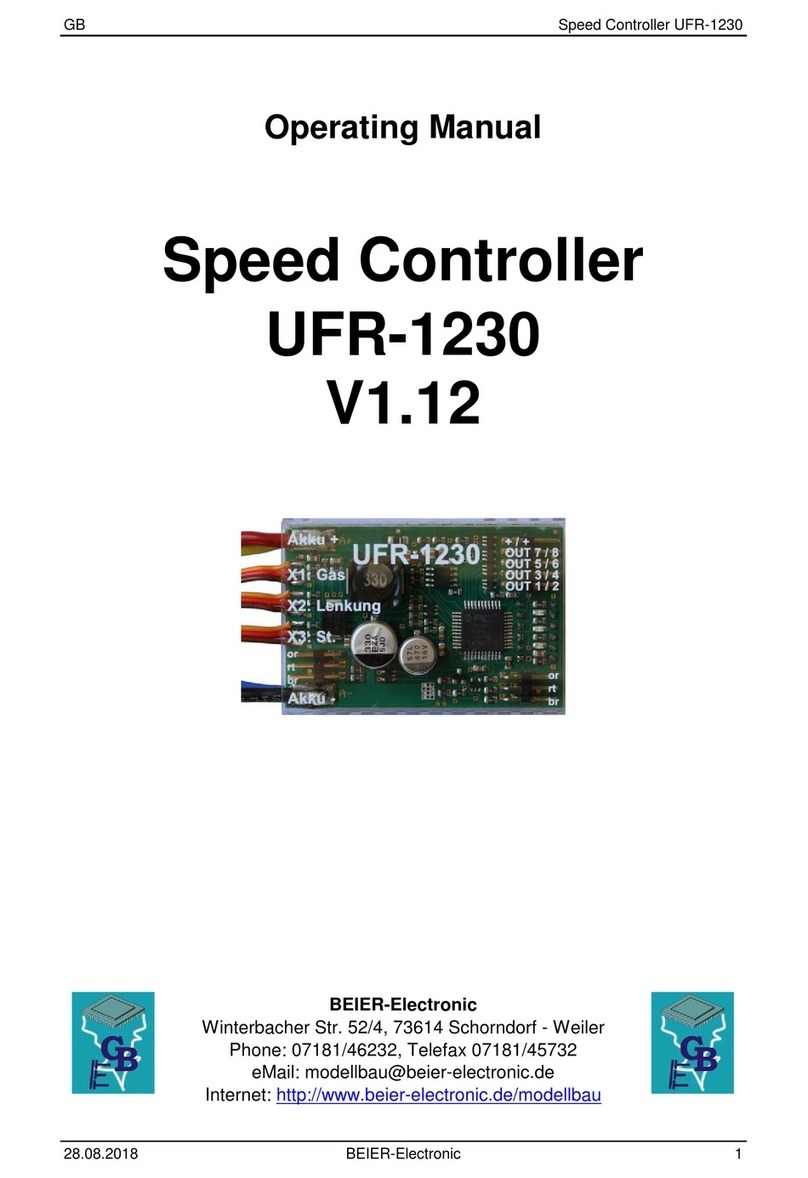
BEIER-Electronic
BEIER-Electronic UFR-1230 User manual
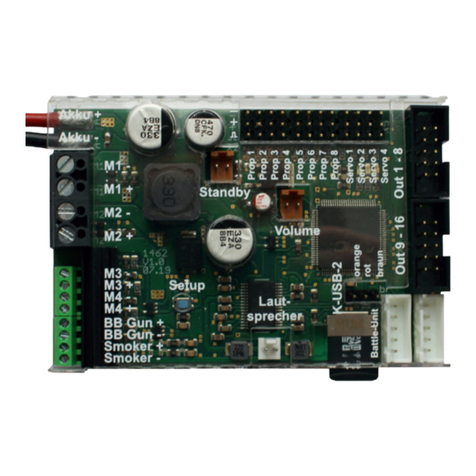
BEIER-Electronic
BEIER-Electronic SFR-1-D User manual
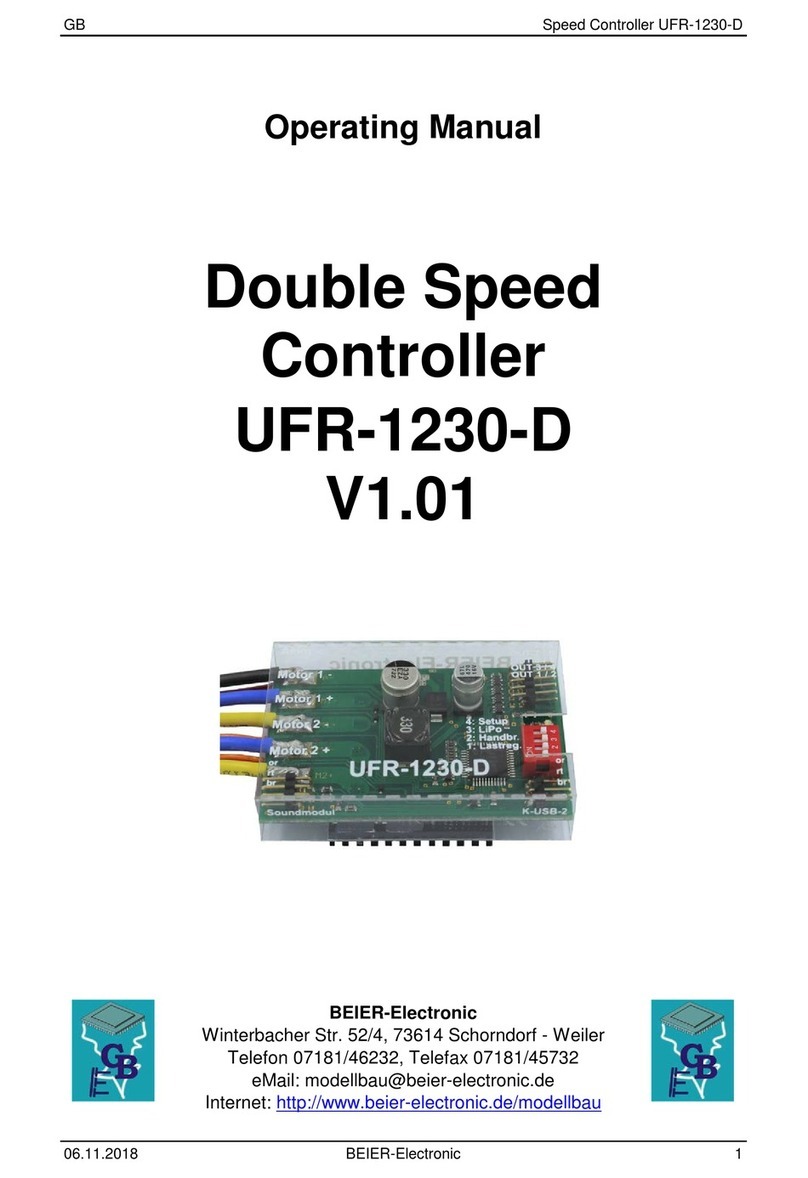
BEIER-Electronic
BEIER-Electronic UFR-1230-D User manual
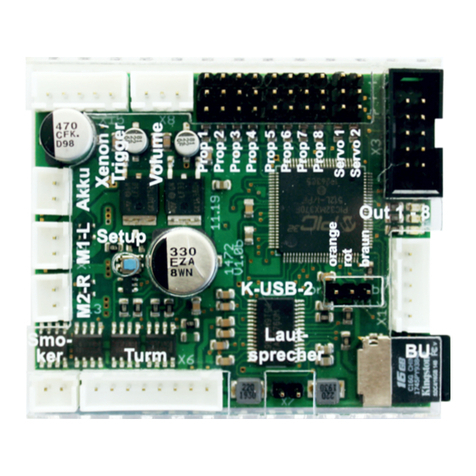
BEIER-Electronic
BEIER-Electronic SFR-1-HL User manual

BEIER-Electronic
BEIER-Electronic SV3-1-8Z User manual

BEIER-Electronic
BEIER-Electronic SV1-2-10Z User manual
